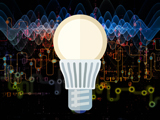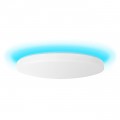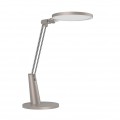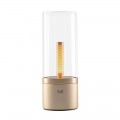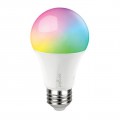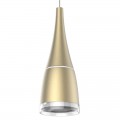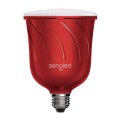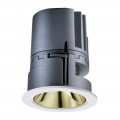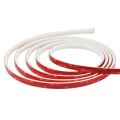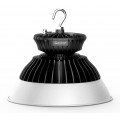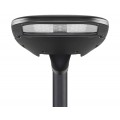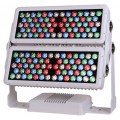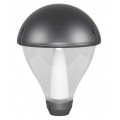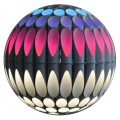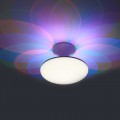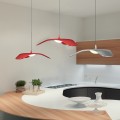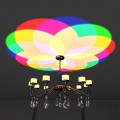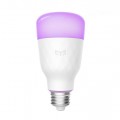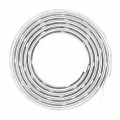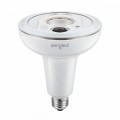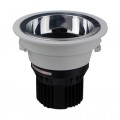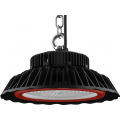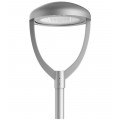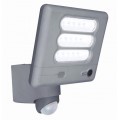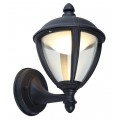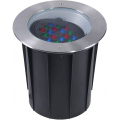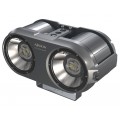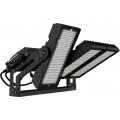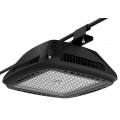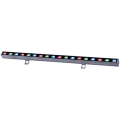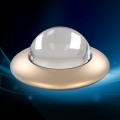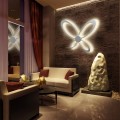An LED driver is a self-contained power supply which includes outputs corresponding to the electrical characteristics of the array of LEDs. Most LED drivers are made to deliver constant currents to operate the array of LEDs. The LED characterized by long lasting qualities is highly desirable as a light source. The LEDs major advantages over the conventional lamps are: significantly more compact, smaller size and weight, increased efficiency, higher efficacy, less heat dissipation, highly proof against mechanical shocks and vibrations, longer lifespan, precisely controlled light spectrum, no ultraviolet or x-Ray radiations and no disposal/recycling problems. The main problem associated to the LED's behavior is the nonlinearity aspect. Because of this, a small increase in voltage applied to the LED can result in a substantial increase in the current and consequently in the emitted light flux. The LEDs display a characteristic curve in direct voltage mode very much like that of the diodes. Hence, a driving circuit needs to be provided to receive energy from the AC mains and uses this energy to drive the LED semiconductors to ultimately generate light. Nonetheless, a lamp that makes use of the LED as a light source and integrates the driving circuit poses several concerns.
The flicker phenomenon occurs during the dead time at a repetition rate of twice the AC sinusoidal frequency. The flicker problem can be fixed by using a rectifier and a capacitor. Even so, a short or leakage in the high-voltage electrolytic capacitor employed to minimize ripple may cause the LED driver circuit to fail, trimming down the rated lifetime of the LED lighting product. The short-life electrolytic capacitor utilized as an energy-storage component in the PFC is the primary reason accounting for the shortened overall lifespan of the whole LED illuminating apparatus, cancelling out the virtues of LED lighting.
A well-known concern with using switching mode power supply is its relative high operation switching frequency. The high frequency signals are simultaneously radiated by the power supply as electromagnetic waves to produce Electromagnetic Interference (EMI) that can also lead to further problems for communications devices in the neighborhood of the power supply. Electromagnetic conduction interference can be depressed by filter circuit (for instance, inductors connected in series or capacitors in parallel). This is the most frequently used solution for lighting sources with integrated electronic driver. However, input filter circuit will raise cost and size of the system. Consequently, the electromagnetic compatibility (EMC) design of the drive power supply remains a big problem that puzzles the designing engineers.
Another challenge involves the fact that the LEDs require rectified AC current which normally requires a relatively sophisticated and high-cost power factor correction circuit. The power factor (PF) parameter represents the real input power as opposed to the apparent input power ratio, and its ideal amount is 1, when the load current graph is matching in shape and phase (i.e., sine-wave) with the voltage graph. Non-linear loads generate harmonic currents aside from the original AC current. Inclusion of linear components such as capacitors and inductors cannot terminate these harmonic currents, so other methods for example filters or active power factor correction are necessary to smooth out their current demand over each cycle of alternating current and therefore reduce the generated harmonic currents. Often described in the same breath with the issue of a low PF is the problem of a high total harmonic distortion (THD).
LED drivers include quite a lot of design constraints that involve trade-offs with PF/THD performance, including switching voltage and electromagnetic interference (EMI) noise correction. Optimizing among the trade-offs associated with dealing with these various constraints is further complicated by working with variable loads that spend much of their operating time at a light load, drawing a fraction of their peak current. The factor leading to high cost is not resulting from the LED chip itself, but by the complicated and expensive driving circuit made up of a filter, a rectifier, a power factor corrector (PFC), etc. to drive LEDs. Such costs, however, also needs to be weighed against the necessary performance criteria of LED drivers.
Therefore, it would be desirable to design a circuit to simplify the electronic circuit, minimize the manufacturing and maintaining costs, remove the flicker phenomenon, as well as increase the power factor. Whenever possible, LED drivers should have these diverse advantages, such as: lower cost, smaller size, fewer parts count, increased efficiency, higher power factor, less harmonics (noise), off line capabilities, and wide range dimming capabilities.












